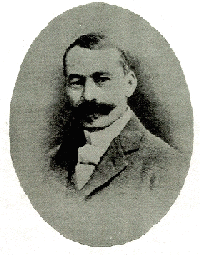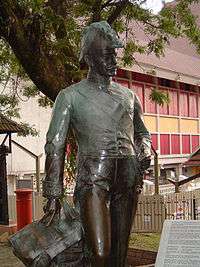Frank Swettenham
| Sir Frank Athelstane Swettenham GCMG CH | |
|---|---|
 Oil painting of Swettenham by John Singer Sargent | |
| King of Arms of the Order of St Michael and St George | |
|
In office 1925–1938 | |
| Preceded by | Sir Montagu Ommanney |
| Succeeded by | Sir William Weigall |
| Majority | British |
| Resident-General of the Federated Malay States | |
|
In office 1896–1901 | |
| Succeeded by | William Hood Treacher |
| Governor and Commander-in-Chief of the Straits Settlements | |
|
In office 1901–1904 | |
| 2nd British Resident of Perak | |
|
In office November 1875 – March 1876 | |
| Preceded by | James W.W. Birch |
| Succeeded by | James G. Davidson |
| 5th British Resident of Perak | |
|
In office 1889–1896 | |
| Preceded by | Hugh Low |
| Succeeded by | William Hood Treacher |
| 3rd British Resident of Selangor | |
|
In office September 1882 – March 1884 | |
| Preceded by | Bloomfield Douglas |
| Succeeded by | John Pickersgill Rodger |
| Personal details | |
| Born |
28 March 1850 Belper, Derbyshire, England |
| Died |
11 June 1946 (aged 96) London, England |
| Spouse(s) |
Constance Sydney Holmes (Sydney Swettenham), m. February 1878, divorced May 1938, no children Vera Seton Guthrie, m. 22 June 1939, no children |
| Residence | King's House, Kuala Lumpur, Malaysia |
| Occupation | British colonial official |
| Religion | Anglo-Catholic |
Sir Frank Athelstane Swettenham GCMG CH (28 March 1850 – 11 June 1946) was the first Resident general of the Federated Malay States, which brought the Malay states of Selangor, Perak, Negeri Sembilan and Pahang together under the administration of a Resident-General based in Kuala Lumpur. He served from 1 July 1896 to 1901. He was also an amateur painter, photographer and antique collector. He was born in Belper, Derbyshire,[1] Britain and was educated at the Dollar Academy in Scotland and St Peter's School, York.[2] He was a descendant of Mathew Swetenham, Henry IV's bow bearer.
He was one of close to forty former British Empire officials to oppose the Malayan Union.
Swettenham co-authored a "A Dictionary of the Malay Language" with Hugh Clifford. The dictionary, which was published in stages between 1894 and 1902, was abandoned after the letter 'G' as by then it had been made redundant by the publiciation of R.J. Wilkinson's "A Malay English Dictionary".[3]
He also published four books "Malay Sketches", "Unaddressed Letters", "Also & Perhaps" and "Arabella in Africa", the latter being illustrated by the famous mural painter and illustrator, Rex Whistler. The book was Whistler's first official commission.
Career between 1871 and 1901

Swettenham was a British colonial official in British Malaya, who was famous as highly influential in shaping British policy and the structure of British administration in the Malay Peninsula.
In 1871 Swettenham was first sent to Singapore as a cadet in the civil service of the Straits Settlements (Singapore, Malacca, and Penang Island). He learned the Malay language and played a major role as British-Malay intermediary in the events surrounding British intervention in the peninsular Malay states in the 1870s.
He was a member of the Commission for the Pacification of Larut set up following the signing of the Pangkor Treaty of 1874 and he served alongside John Frederick Adolphus McNair, and Chinese Kapitan Chung Keng Quee and Chin Seng Yam. The Commission was successful in freeing many women taken as captives during the Larut Wars (1862–73), getting stockades dismantled and getting the tin mining business going again.
More than a decade later, in 1882, he was appointed as resident (adviser) to the Malay state of Selangor. In Selangor office, the development of coffee and tobacco estates had successfully promoted by him, while in the meantime, helped boost tin earnings by constructing a railway from Kuala Lumpur (it was capital of Selangor at that time), to the port of Klang, which was later named Port Swettenham in his honour.
He attended the federation, along with the title of resident-general after he secured an agreement of federation from the states of Perak, Selangor, Negri Sembilan, and Pahang in 1895, when he was a resident of Perak state. In 1897 he was knighted by Queen Victoria, and in October 1901, three years before his retirement, he was appointed Governor and Commader-in-Chief of the Straits Settlements.[4]
Swettenham had long been critical of the influence of Siam in the northern Malay states of Kelantan and Trengganu, which had traditionally recognised the suzerainty of Siam by sending a tribute of a golden flower to the King of Siam every three years. After his appointment as Governor of the Straits Settlements, he attempted to negotiate with Siam for greater British influence over the affairs of these states. Siam reluctantly agreed to appoint British advisors, but only on the condition that they were appointed by Bangkok, not by the Foreign Office as he had hoped. However, the process had been initiated whereby these two states and eventually Kedah would eventually accept British Residents. Swettenham was disappointed in his ultimate goal of bringing the southern Thai region of Patani under British control.[5]
Personal life
While on home leave in England in the summer of 1877, Swettenham met and became engaged to Constance Sydney Holmes (b. 1858), daughter of Cecil Frederick Holmes, a housemaster at Harrow School. They married in England in February 1878 and returned together to Singapore, where the nineteen-year old Sydney Swettenham attempted to come to terms with her new role as the wife of a colonial official. Their marriage, which was strained from the beginning and marked by long periods of separation, lasted until 1938, when Frank Swettenham successfully sued for divorce on the grounds of his wife's insanity.[6]
Swettenham became friends with Gertrude Bell when she visited Singapore in 1903 and maintained a correspondence with her until 1909.[7] They are thought to have had a "brief but passionate affair" with after his retirement to England.[8]
Frank Swettenham remarried at the age of 89, this time to Vera Seton Guthrie (1890–1970), daughter of John Gordon, a successful merchant, and widow of John Neil Guthrie, who had been killed in action in France during World War I.[9]
While in India in 1883 preparing for the Colonial Exhibition in Calcutta, Swettenham met and had a child with an Anglo-Indian woman from Bangalore (known only as Miss Good). To avoid a scandal, the mother of Swettenham's son was married to an English clerk in the Perak civil service, Walter McKnight Young, and his son was raised as Walter Aynsley Young.[10]
Chronology


- He was Deputy Commissioner with the Perak Expedition from 1875–1876.
- British Resident of Selangor in 1882, of Perak from 1889–1895.
- Resident-General of the Federated Malay States (now Malaysia) in 1896–1901.
- Governor and Commander-in-Chief of the Straits Settlements 1901–1904.
- Chaired the royal commission to enquire into the affairs of Mauritius in 1909.
- He was also joint director of the Official Press Bureau from 1915–1919.
Legacy
A number of places and roads in Malaysia and Singapore were named after Swettenham, including Swettenham Pier in George Town, Penang Island[11][12] and Swettenham Road (near the Botanic Gardens) in Singapore.
Before 1972, Port Klang in Selangor was known as Port Swettenham.
Publication
- Burns, P.L., and Cowan, C.D. ed. (1975), 'Sir Frank Swettenham's Malayan journals 1874–1876', Kuala Lumpur, London: Oxford University Press.
- Clifford, Hugh Charles, and Swettenham, Frank Athelstane (1894), 'A dictionary of the Malay language', Taiping, Perak: Printed for the author's at the Government's printing office.
- Cowan, C.D. ed. (1952), 'Sir Frank Swettenham's Perak journals 1874–1876', 'Journal of the Malayan branch of the Royal Asiatic Society', vol.24, part 4. Singapore: Malaya Publishing House.
- Swettenham, Frank Athelstane (1881), 'Vocabulary of the English and Malay languages'. Singapore: printed at the Government Printing Office.
- Swettenham, Frank Athelstane (1893), 'Map to illustrate the Siamese question'. W. & A.K. Johnston Limited.
- Swettenham, Frank Athelstane (1893), 'About Perak'. Singapore: Straits Times Press.
- Swettenham, Frank Athelstane (1895), 'Malay sketches'. London: John Lane.
- Swettenham, Frank Athelstane (1898), 'Unaddressed letters'. London: John Lane.
- Swettenham, Frank Athelstane (1899), 'The real Malay'. London: John Lane.
- Swettenham, Frank Athelstane (1907), 'British Malaya'. London: John Lane.
- Swettenham, Frank Athelstane (1910), 'Report of the Mauritius royal commission, 1909'. HMSO.
- Swettenham, Frank Athelstane (1912), 'Also and perhaps'. London: John Lane.
- Swettenham, Frank Athelstane (1925), 'Arabella in Africa'. London: John Lane.
- Swettenham, Frank Athelstane (1942), 'Footprints in Malaya'. London: Hutchinson.
- Swettenham, Frank Athelstane (1946 ?), 'The future of Malaya'. [S.l.]: [s.n.]
- Swettenham, Frank Athelstane (1967), 'Stories and sketches'. Kuala Lumpur: Oxford University Press.[13]
See also
Corresp: Actions of Perak Expeditionary Force post-murder of Birch
References
- ↑ Frank Swettenham at biography.com
- ↑ Barlow, Henry S. (1995). Swettenham. Kuala Lumpur: Southdene. p. 4.
- ↑ Barlow, Henry S. (1995). Swettenham. Kuala Lumpur: Southdene. p. 477.
- ↑ The London Gazette: no. 27360. p. 6395. 1 October 1901.
- ↑ Barlow, Henry S. (1995). "Chapter 39 The Problem of Siam: Reality of Failure". Swettenham. Kuala Lumpur: Southdene.
- ↑ Barlow, Henry S. (1995). Swettenham. Kuala Lumpur: Southdene. p. 186.
- ↑ Barlow, Henry S. (1995). Swettenham. Kuala Lumpur: Southdene. pp. 654–5.
- ↑ Barlow, Henry S. (1997). "Malaysia: Swettenham's Legacy". Asian Affairs. 28 (3): 333.
- ↑ Barlow, Henry S. (1995). Swettenham. Kuala Lumpur: Southdene. p. 721.
- ↑ Williams, Stephanie (2011). Running the Show: the extraordinary stories of the men who governed the British Empire. London: Penguin. p. 254.
- ↑ Wright, Arnold; Cartwright, H. A. (1908). Twentieth Century Impressions of British Malaya: Its History, People, Commerce, Industries, and Resources. Lloyd Greater Britain Publishing. p. 730.
- ↑ "Swettenham Pier". Penang Global Tourism.
- ↑ Cambridge University Library 2003: from , dated 10 May 2004.
External links
- Works by or about Frank Swettenham at Internet Archive
- Britannica | Sir Frank Swettenham
- Association of British Malaya
- Carcosa Seri Negara
- Straits Settlements
| Heraldic offices | ||
|---|---|---|
| Preceded by Sir Montagu Ommanney |
King of Arms of the Order of St Michael and St George 1925–1938 |
Succeeded by Sir William Weigall |
| Political offices | ||
| Preceded by James W. W. Birch |
British Resident of Perak 1875–1876 |
Succeeded by James G. Davidson |
| Preceded by Hugh Low |
British Resident of Perak 1889–1896 |
Succeeded by William H. Treacher |
| Preceded by William Bloomfield Douglas |
British Resident of Selangor 1882–1884 |
Succeeded by John Pickersgill Rodger |